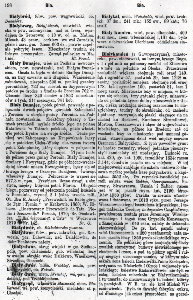The Parish of
Bilyi Kamin (Білий Камінь) /
Biały Kamień
in
Słownik geograficzny Królestwa
Polskiego
i innych krajów słowiańskich
Geographic Dictionary of the Kingdom of Poland and other
Slavic Countries
15 volumes. 1880-1902
Graphic Illustrations for Bilyi Kamin (Білий Камінь) /
Biały Kamień:

Bialy Kamien (with Gawroszczyzna). Town, in Zloczow county, on the left
shore of the Bug River, within 1.5 leagues to the northwest of Zloczow, within a
league south of Olesko. The major estate covers 140 Austrian morgs of
farmland, 57 of meadows and gardens, 29 of pastureland and 1228 of forests.
The minor estate covers 178 Austrian morgs of farmland, 100 of meadows and
gardens, 81 of pastureland and 1 of forests. The town lies in a place
where 3 kinds of soil grow, mainly from the southern Zloczow fertile plains with
greasy heavy fertile land; the black earth here is not deep, hard to plough;
from the west and south the sandy soil begins, drawing westwards towards Busk,
Kamionka Strumilowa, Most, Cieszanow and continuing towards Lublin province.
But from the east this town lies under mountains establishing a watershed
between the Black and Baltic Seas. For these seasons the ground is very
diverse, more so however, the sandy and rocky lowland.
The population is 3144, made up of 420 Roman Catholics, 1090 Greek Catholics
(Ukrainian Catholics) and 1634 Jews. The Ukrainian Catholic Parish is
found in town. In this town was founded a school of the third class and a
gmina loan society with a capital of 2552 zloty. To the Roman Catholic
parish belong the villages of Belzec, Czeremosznia, Poczapy, Skwarzawa, Usznia
and Zulice. Together in this parish are 2190 Roman Catholics and 1950
Jews. The parish was founded and dates to 1613 by Jerzy Wiszniowiecki, of
the Kyiv Castellan and his wife Gryzelda Konstancya from Zamojsk, since 1640 it
has belonged to the deanery of Zloczow. To the Greek Catholic (Ukrainian
Catholic) parish there belongs the village Czeremosznia with 260 parishioners;
therefore, the entire parish counts 1350 Ukrainian Catholic believers. By
the nearest hill are found traces of ancient buildings of unknown extraction and
time, and under which is a beautiful garden and ruins of a defensive castle in
which lived the wife of Prince Radziwill, his wife Kochanka, crowned in Nieswiez
and Olyca in Wilno province; The Radziwill principality didn't live there.
The princes lived in town (Bialy Kamien) and died there. Until recently
people still lived here in the castle. In Bialy Kamien, King Michal
Wisniowecki was born. Long ago there was a sugar factory, which had been
converted into a distillery. The owner of the major estate is Felix Bogusz
and heirs of the Schneider family. (Click on the image to make it
larger.)
Graphic Illustrations for Cheremoshnia (Черемошня)
/
Czeremosznia:

Village, in the county of Zloczow on the Bug river, a quarter of
a mile to the east of Bialy Kamien, a half mile to the northwest of Zloczow, a
mile south of Olesko. The major estate covers 399 Austrian morgs, 46 of
meadows and gardens, 42 of pastureland, 444 of forest; the minor estate covers
924 Austrian morgs, 201 of meadows and gardens, 65 of pastureland, 2 of forests.
People: 195 Roman Catholics, 260 Greek Catholics (Ukrainian Catholics), 64 Jews.
All total 519. Both churches belong to Bialy Kamien parish. In this
village is a loan society with funds of 143 zloty.
(Click on the image to make it larger.)
Ushnia (Ушня) / Usznia:
Village in the county of Zloczow, 10km to the north of Zloczow,
9km to the southwest of the judicial district of Sassow. To the north lies
Bialy Kamien (with Gawaraczyzna), Olesko and Hucisko Oleskie, to the east is
Pobocz, to the southeast in Sassow, to the southwest is Zulice, to the west is
Czeremosznia. The southern part of the village flows the Bug River from
the east from Sassow and onto Czeremosznia. In the valley of the Bug
River, on the right bank, lie the buildings. To the northeast rises the
hill Homiec (362 meters), to the northwest rises the hill Turycha at 320 meters.
The major estate covers 94 Austrian morgs, 5 of meadows and gardens, 19 of
pastureland, 331 of forests; the minor estate covers 1680 Austrian morgs,
536 of meadows and gardens, 95 of pastureland, 2 of forests. In the year
1880 there were 253 houses and 1677 residents (1170 Roman Catholics, 411 Greek
Catholics, a.k.a. Ukrainian Catholics, 96 Jews; 1398 ethnic Poles, 279
ethnic Ukrainians). The Roman Catholic parish is in Bialy Kamien, the
Greek Catholic parish in Sassow. In this village is a wooden church, a
school of the first level (from 1847) with language instruction in Polish.
There's a gmina loan society with a capital of 1878 zloty. A part of the
population works in pottery factories.
For information regarding this gazetteer and learning its history,
availability and usage, visit my site on
Słownik geograficzny Królestwa Polskiego i innych krajów słowiańskich
(Geographic Dictionary of the Kingdom of Poland and other Slavic Countries)
15 volumes. 1880-1902.
|